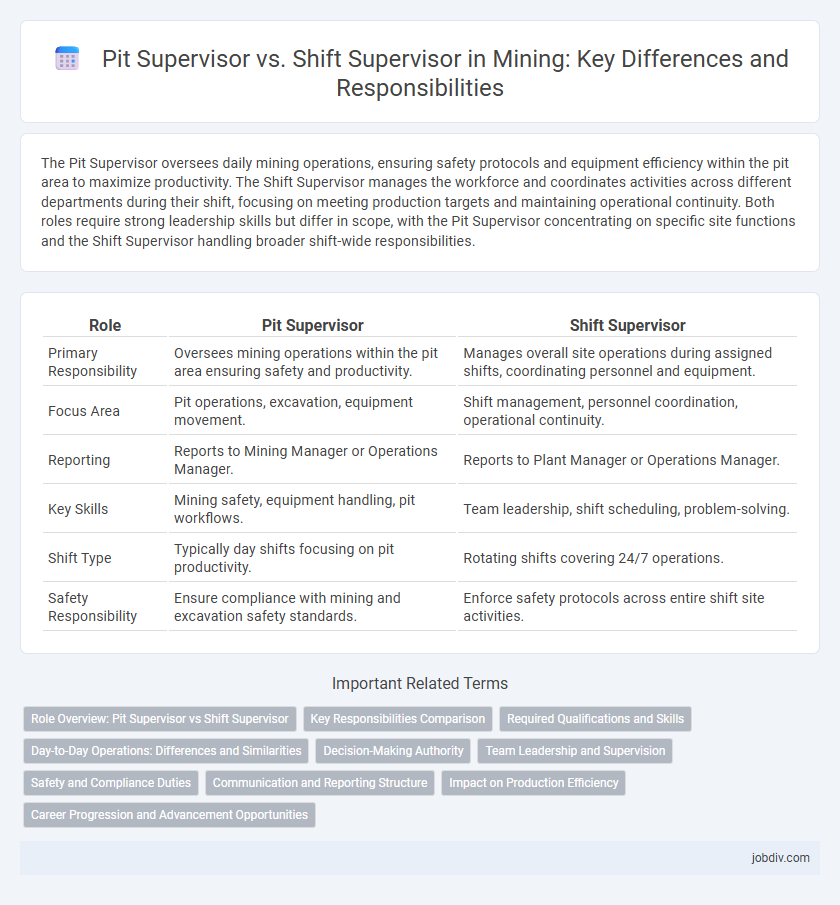The Pit Supervisor oversees daily mining operations, ensuring safety protocols and equipment efficiency within the pit area to maximize productivity. The Shift Supervisor manages the workforce and coordinates activities across different departments during their shift, focusing on meeting production targets and maintaining operational continuity. Both roles require strong leadership skills but differ in scope, with the Pit Supervisor concentrating on specific site functions and the Shift Supervisor handling broader shift-wide responsibilities.
Table of Comparison
| Role | Pit Supervisor | Shift Supervisor |
|---|---|---|
| Primary Responsibility | Oversees mining operations within the pit area ensuring safety and productivity. | Manages overall site operations during assigned shifts, coordinating personnel and equipment. |
| Focus Area | Pit operations, excavation, equipment movement. | Shift management, personnel coordination, operational continuity. |
| Reporting | Reports to Mining Manager or Operations Manager. | Reports to Plant Manager or Operations Manager. |
| Key Skills | Mining safety, equipment handling, pit workflows. | Team leadership, shift scheduling, problem-solving. |
| Shift Type | Typically day shifts focusing on pit productivity. | Rotating shifts covering 24/7 operations. |
| Safety Responsibility | Ensure compliance with mining and excavation safety standards. | Enforce safety protocols across entire shift site activities. |
Role Overview: Pit Supervisor vs Shift Supervisor
A Pit Supervisor oversees all mining operations within the pit, ensuring safety compliance, workflow efficiency, and resource management specific to surface extraction activities. A Shift Supervisor manages the overall workforce, production targets, and safety protocols across various mining departments during a designated shift, coordinating between equipment operators and site management. Both roles require strong leadership and operational expertise, but the Pit Supervisor is more focused on onsite pit activities while the Shift Supervisor handles broader shift-based operational control.
Key Responsibilities Comparison
The Pit Supervisor is primarily responsible for overseeing extraction operations, ensuring safety protocols within the pit, and managing equipment efficiency during mining activities. The Shift Supervisor coordinates all shift personnel, monitors production targets, enforces safety standards, and handles real-time operational decisions across multiple teams. Both roles emphasize safety compliance and operational efficiency but differ in scope, with the Pit Supervisor focusing on specific pit operations and the Shift Supervisor managing broader shift-wide responsibilities.
Required Qualifications and Skills
Pit Supervisors typically require extensive experience in underground or surface mining operations, strong technical knowledge of mining equipment, and a certification in mine safety and health standards. Shift Supervisors need proven leadership abilities, proficiency in operational planning, and expertise in monitoring shift productivity while ensuring compliance with safety protocols. Both roles demand excellent problem-solving skills, effective communication, and a solid understanding of mining regulatory requirements.
Day-to-Day Operations: Differences and Similarities
Pit Supervisors oversee the direct extraction activities, ensuring efficient drilling, blasting, and material handling within the pit, while Shift Supervisors manage overall site operations during their shifts, coordinating between different teams and ensuring safety protocols are followed. Both roles require strong leadership and real-time problem-solving skills, with Pit Supervisors focusing more on technical execution and Shift Supervisors on operational continuity and workforce management. Their collaboration is crucial for maintaining productivity and minimizing downtime in mining operations.
Decision-Making Authority
Pit Supervisors hold direct decision-making authority over daily excavation operations and equipment deployment, ensuring safety and production targets are met within the mine pit. Shift Supervisors oversee broader operational activities across multiple sections during their shift, making strategic decisions that affect workforce coordination and resource allocation. The Pit Supervisor's decisions focus on tactical execution, while the Shift Supervisor's authority encompasses both tactical and operational management.
Team Leadership and Supervision
Pit Supervisors oversee on-site mining operations, directly managing extraction teams to ensure safety protocols and productivity targets are met within the pit. Shift Supervisors coordinate multiple teams across different mine sections during their shifts, focusing on operational continuity and conflict resolution among personnel. Both roles require strong leadership skills, but Pit Supervisors engage more with hands-on team guidance, whereas Shift Supervisors emphasize broader shift coordination and resource allocation.
Safety and Compliance Duties
Pit Supervisors oversee daily mining operations, ensuring adherence to safety protocols specific to pit activities, such as ground control and equipment inspections. Shift Supervisors manage overall shift operations with a focus on enforcing compliance with company safety standards and regulatory requirements across all site activities. Both roles are critical for maintaining workplace safety and regulatory compliance, but Pit Supervisors specialize in on-site hazard identification, while Shift Supervisors coordinate broader safety enforcement and reporting.
Communication and Reporting Structure
A Pit Supervisor manages daily mining operations on-site, coordinating equipment and workforce to optimize pit activities, while a Shift Supervisor oversees overall personnel and safety during assigned shifts across multiple areas. Effective communication for a Pit Supervisor involves direct interaction with equipment operators and immediate reporting to the Shift Supervisor. The Shift Supervisor consolidates these reports to inform higher management and ensures smooth operational continuity through structured communication channels.
Impact on Production Efficiency
A Pit Supervisor directly oversees on-site mining operations, ensuring equipment functionality and adherence to safety protocols, which leads to immediate improvements in production efficiency. In contrast, a Shift Supervisor coordinates multiple teams and manages workflow scheduling, impacting efficiency by optimizing labor allocation and minimizing downtime across shifts. Effective communication between both roles enhances overall production efficiency by synchronizing operational tasks with strategic resource management.
Career Progression and Advancement Opportunities
Pit Supervisors oversee daily mining operations, ensuring safety and productivity on-site, while Shift Supervisors manage overall shift activities, coordinating teams across multiple pits or sections. Career progression from Pit Supervisor to Shift Supervisor typically involves gaining broader leadership experience and mastering operational logistics, opening pathways to higher managerial roles such as Operations Manager or Mine Manager. Advancement opportunities depend on demonstrated skills in team coordination, safety compliance, and operational efficiency, critical for assuming greater responsibilities within mining enterprises.
Pit Supervisor vs Shift Supervisor Infographic

 jobdiv.com
jobdiv.com